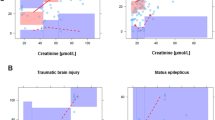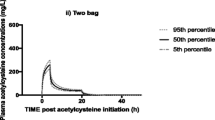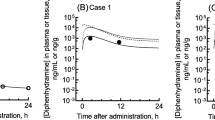Abstract
Objective
To develop guidelines for the management of QT prolongation after citalopram overdose, including decontamination with single-dose activated charcoal (SDAC) and cardiac monitoring.
Design
Simulation study using a previously developed pharmacokinetic-pharmacodynamic (PKPD) model which predicted the time-course of QT prolongation and the effect of citalopram dose and use of SDAC on QT prolongation.
Main measures and results
The previously developed PKPD model was used to address the following in patients following citalopram overdose: (1) Above what dose should patients be decontaminated? (2) Above what dose should patients have cardiac monitoring? (3) For what period of time should patients be monitored? The primary outcome was QT,RR combinations above an abnormal threshold as a surrogate predictor of torsades de pointes. Simulations were performed using MATLAB for an overdose patient with typical demographics: 30-year-old female with a heart rate of 79 bpm taking citalopram therapeutically. The simulations showed: (1) There was significant benefit associated with the administration of SDAC to patients following citalopram overdose ingesting > 600 mg; (2) With citalopram overdoses > 1,000 mg it was advisable to give SDAC and cardiac monitor the patient; (3) The risk of developing future abnormal QT,RR combinations was less than 1% in patients with normal QT,RR combinations up to 13 h post-dose, so the minimum monitoring time for citalopram overdoses > 1,000 mg should be 13 h. Recommended dose levels for intervention should be lowered in older patients and patients with tachycardia, while men are less sensitive to QT prolongation.
Conclusions
Guidelines for the management of QT prolongation after citalopram overdose were developed. We believe the model will help clinicians to decide which patients to decontaminate and monitor.


Similar content being viewed by others
References
Isbister GK, Bowe SJ, Dawson A, Whyte IM (2004) Relative toxicity of selective serotonin reuptake inhibitors (SSRIs) in overdose. J Toxicol Clin Toxicol 42:277–285
Personne M, Sjöberg G, Persson H (1997) Citalopram overdose—review of cases treated in Swedish hospitals. J Toxicol Clin Toxicol 35:237–240
Meuleman C, Jourdain P, Bellorini M, Sadeg N, Loiret J, Guillard N, Thebault B, Funck F (2001) [Citalopram and Torsades de Pointes. A case report]. Arch Mal Coeur Vaiss 94:1021–1024
Tarabar AF, Hoffman RS, Nelson LS (2003) Citalopram overdose: Late presentation of Torsades de Pointes (TdP) with cardiac arrest [abstract]. J Toxicol Clin Toxicol 41:676
Ostrom M, Eriksson A, Thorson J, Spigset O (1996) Fatal overdose with citalopram. Lancet 348:339–340
Jonasson B, Saldeen T (2002) Citalopram in fatal poisoning cases. Forensic Sci Int 126:1–6
Chew DP, Allan RM, Aroney CN, Sheerin NJ (2005) National data elements for the clinical management of acute coronary syndromes. Med J Aust 182:S1–14
Bond GR (2002) The role of activated charcoal and gastric emptying in gastrointestinal decontamination: a state-of-the-art review. Ann Emerg Med 39:273–286
Cooper GM, Le Couteur DG, Richardson D, Buckley NA (2005) A randomized clinical trial of activated charcoal for the routine management of oral drug overdose. QJM 98:655–660
Friberg LE, Isbister GK, Duffull SB (2006) Pharmacokinetic-pharmacodynamic modelling of QT interval prolongation following citalopram overdoses. Br J Clin Pharmacol 61:177–190
Rampono J, Kristensen JH, Hackett LP, Paech M, Kohan R, Ilett KF (2000) Citalopram and demethylcitalopram in human milk; distribution, excretion and effects in breast fed infants. Br J Clin Pharmacol 50:263–268
Friberg LE, Isbister GK, Hackett LP, Duffull SB (2005) The population pharmacokinetics of citalopram after deliberate self-poisoning: a Bayesian approach. J Pharmacokinet Pharmacodyn 32:571–605
Moss AJ (1999) The QT interval and torsade de pointes. Drug Saf 21:1:5–10
Malik M, Farbom P, Batchvarov V, Hnatkova K, Camm AJ (2002) Relation between QT and RR intervals is highly individual among healthy subjects: implications for heart rate correction of the QT interval. Heart 87:220–228
Fossa AA, Wisialowski T, Magnano A, Wolfgang E, Winslow R, Gorczyca W, Crimin K, Raunig DL (2005) Dynamic beat-to-beat modeling of the QT-RR interval relationship: analysis of QT prolongation during alterations of autonomic state versus human ether a-go-go-related gene inhibition. J Pharmacol Exp Ther 312:1–11
Balit CR, Isbister GK, Hackett LP, Whyte IM (2003) Quetiapine poisoning: a case series. Ann Emerg Med 42:751–758
Isbister GK, Balit CR (2003) Bupropion overdose: QTc prolongation and its clinical significance. Ann Pharmacother 37:999–1002
Batchvarov VN, Ghuran A, Smetana P, Hnatkova K, Harries M, Dilaveris P, Camm AJ, Malik M (2002) QT-RR relationship in healthy subjects exhibits substantial intersubject variability and high intrasubject stability. Am J Physiol Heart Circ Physiol 282:H2356–H2363
Sidhu J, Priskorn M, Poulsen M, Segonzac A, Grollier G, Larsen F (1997) Steady-state pharmacokinetics of the enantiomers of citalopram and its metabolites in humans. Chirality 9:686–692
Kragh-Sorensen P, Overo KF, Petersen OL, Jensen K, Parnas W (1981) The kinetics of citalopram: single and multiple dose studies in man. Acta Pharmacol Toxicol (Copenh) 48:53–60
Malik M, Hnatkova K, Batchvarov V, Gang Y, Smetana P, Camm AJ (2004) Sample size, power calculations, and their implications for the cost of thorough studies of drug induced QT interval prolongation. Pacing Clin Electrophysiol 27:1659–1669
Acknowledgements
Geoff Isbister is funded by an NHMRC Clinical Career Development Award ID300785. Lena Friberg was supported by a research grant from Knut and Alice Wallenberg foundation, Stockholm, Sweden
Author information
Authors and Affiliations
Corresponding author
Additional information
G.K. I. and S.B. D. conceived and, with L.E. F., designed the study. G.K. I. supervised the clinical study and data collection. L.E. F. undertook pharmacokinetic-pharmacodynamic modelling and simulations based on the model, under the supervision of S.B. D.
Electronic supplementary material
Rights and permissions
About this article
Cite this article
Isbister, G.K., Friberg, L.E. & Duffull, S.B. Application of pharmacokinetic-pharmacodynamic modelling in management of QT abnormalities after citalopram overdose. Intensive Care Med 32, 1060–1065 (2006). https://doi.org/10.1007/s00134-006-0183-9
Received:
Accepted:
Published:
Issue Date:
DOI: https://doi.org/10.1007/s00134-006-0183-9




